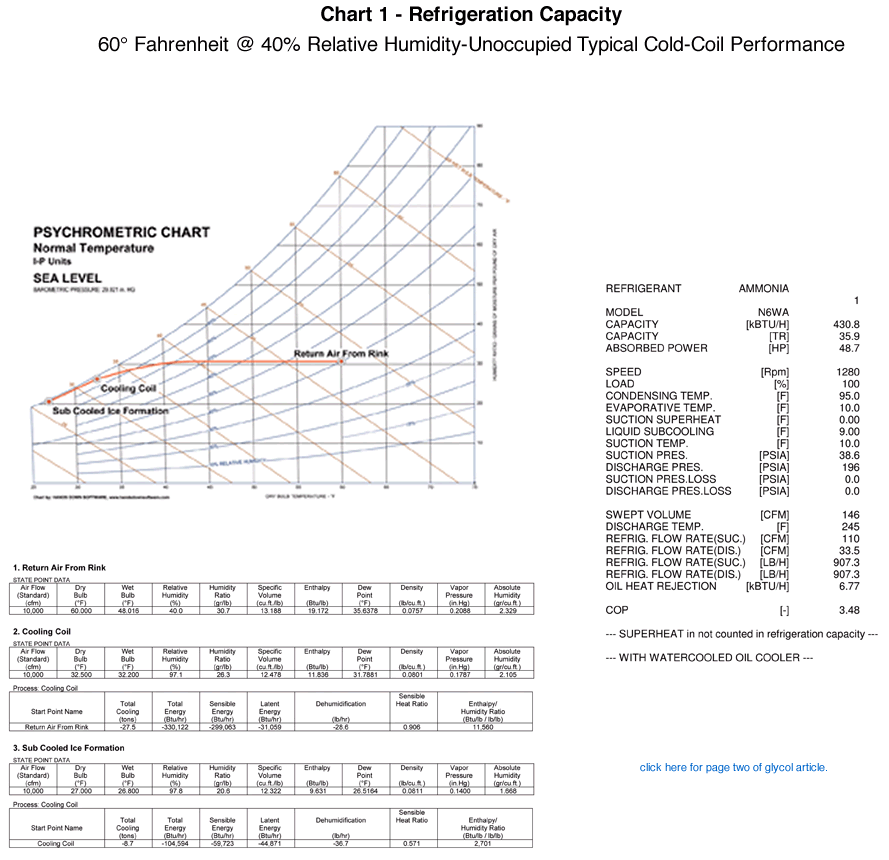
|
|
| Comparison of Glycol Refrigeration Dehumidification to Desiccant Dehumidification | ||||||
|
||||||
Climate by Design International (CDI) has specialized in providing Desiccant Dehumidifiers for ice arenas for over 25 years. The first desiccant system installed replaced a cold-coil system that was supplied with low-temperature glycol from a rink chiller plant using ammonia refrigeration; a hot water coil was used to reheat the air after the dehumidification coil. The customer complained of poor dehumidification performance in the spring, summer and fall, coupled with high energy costs associated with the low-temperature chiller. The system we replaced closely resembled those now offered as a "New Solution" for dehumidification in indoor ice arenas. A properly sized, natural-gas-fired desiccant unit was installed, resulting in an energy savings of over $20,000 per year. Since that first installation, desiccant dehumidifiers have provided superior humidity control for over 500 arenas in North America. A technical paper was published by ASHRAE which reviews a case study of the original project. (Copies can be obtained from ASHRAE reprints) Desiccant systems are sized to maintain approximately 32°F to 35°F dew points in the arena. This relieves the latent load on the low-temperature rink chiller system. |
The desiccant unit supplies air at a 10°F to 20°F dew point to control the infiltrated load and can also be designed to condition fresh air to comply with ventilation standards. Sufficient capacity to adequately dry the rink in a normal operating condition is the key to sizing a system. Current building codes require outside air to be brought in to ventilate anytime the rink is operated. Local code officials should be consulted to determine ventilation standards for occupied operation. Glycol-type or low-temperature coils used for refrigeration use a cold coil to cool the air; as the air reaches dew point temperature, water vapor condenses on the cold coil; if the coil fluid temperatures are below 32°F, some or all the water that condenses will form ice or frost on the coil; at some velocities, snow is also formed. After the cooling process, the air is heated to lower the relative humidity, and to avoid overcooling the controlled space. Typically, these systems require more airflow to remove humidity for an ice arena than a properly sized desiccant system. Desiccant dehumidification uses a permanent, stabilized silica gel wheel to remove water vapor from the air. The wheel is reactivated using heat energy, propane, natural gas or electricity; typically, natural gas will provide the best cost benefit as compared to electricity, but different regions should compare energy sources to pick the most cost-effective fuel source. Glycol cooling coils or D/X refrigeration systems were used in the early days of humidity control but are considered difficult to operate and energy intensive. The capacity available is always limited by ice formation on the cold coil. The airflow is also restricted when ice and frost form on the coil. Chart 1 and 2 (see below) are comparisons of a cold glycol coil supplied from the return line of an ice chiller system and a desiccant dehumidifier of similar airflow. At this airflow, the water removal of the desiccant system is three times the removal capacity of the glycol coil. |
|||||
Chart 1 shows a rink condition of 60°F @ 40% RH with 0% outside air. The total moisture removal is shown at 65.3 lbs/hr; over half the water vapor removed forms ice or frozen water vapor on the coil. This ice will reduce the effectiveness of the cold coil and reduce performance between required defrost cycles. As ice forms on the cold coil, the air resistance increases and reduces airflow, further limiting dehumidifier performance. The ice also acts as an insulator; this limits the cooling potential of the coil. |
During the defrost cycle, a percentage of the water will vaporize back into the arena. The system must remove this defrost vaporization again and again. During the defrost cycle, the unit will not remove water; it actually puts water back into the rink. If we assume a ten minute- per-hour defrost cycle to clear the coil of ice, the average performance is reduced to 54.41 lbs/hr actual moisture removal. | |||||
 |
|
||||
| © Copyright 2021 - Climate by Design International, Inc. (CDI) |

